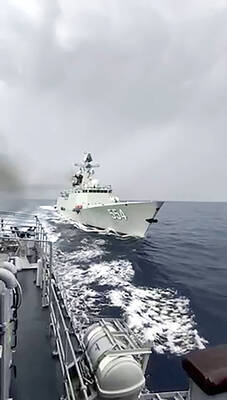The US has made a breakthrough in perfecting a new laser weapons system that may one day be used to defend Taiwan.
It is a laser or ray-gun type weapon that will eventually be able to take down multiple enemy missiles at the same time.
At a Congressional hearing on Wednesday, Larry Wortzel, a military expert with a special knowledge of Taiwan, was asked by US Republican Representative Steven Chabot about the approximately 1,100 Chinese missiles targeting Taiwan.
“Clearly, China has been threatening Taiwan for many, many years and bullying to a considerable degree. Relative to the missiles, is there anti-missile technology that would be helpful?” Chabot asked.
“My personal view is that we need to be working on lasers,” Wortzel said. “We don’t want to be shooting two or three missiles at another missile. We need to melt them right out of the sky, quickly.”
Later that day — and coincidentally — the US Office of Naval Research issued a statement saying that scientists at Los Alamos National Laboratory, New Mexico, had achieved a “remarkable breakthrough” in the Free Electron Laser (FEL) program.
They have perfected an “injector” capable of producing the electrons needed to generate megawatt-class laser beams for the Navy’s next-generation weapons system.
The breakthrough is being studied at a two-day design review conference in Virginia this weekend.
FEL program manager Quentin Saulter said the implications of the progress were “monumental.”
“This is a major leap forward for the program and for FEL technology,” he said.
Another scientific report says that the US Navy’s megawatt laser now has the potential to “zap enemy planes out of the sky and disable missile threats.”
“This revolutionary technology allows for multiple payoffs to the war fighter,” the Office of Naval Research said. “The ability to control the strength of the beam provides for graduated lethality. In fact, it provides an effective alternative to using expensive missiles against low value targets.”
“Not worrying about propulsion and working at the speed of light allows for precise engagement and the resulting low collateral damage,” it said.
What it means is that a large ship — or an island nation like Taiwan — would be able to shoot down very large numbers of incoming missiles at low cost and long before they reached their targets.
Last year, Reuters reported that a high-powered laser aboard a modified Boeing 747 jumbo jet shot down an in-flight ballistic missile for the first time.
“The revolutionary use of directed energy is very attractive for missile defense,” a statement from the Pentagon read.
Much of the development information about laser weapons is top secret and highly classified, but one source predicted they would be ready for testing over water in five to seven years.
As yet unforeseen problems could arise, but if the ray guns go into production they might allow Taiwan to defend against China’s ever-growing missile force.
A Pentagon source said that he agreed with Wortzel and that the laser anti-missile system might be ideal for Taiwan.
The source added that because such a system would be strictly defensive, the US might also be “well inclined” to sell it to Taipei when it becomes available.

DEFENDING DEMOCRACY: Taiwan shares the same values as those that fought in WWII, and nations must unite to halt the expansion of a new authoritarian bloc, Lai said The government yesterday held a commemoration ceremony for Victory in Europe (V-E) Day, joining the rest of the world for the first time to mark the anniversary of the end of World War II in Europe. Taiwan honoring V-E Day signifies “our growing connections with the international community,” President William Lai (賴清德) said at a reception in Taipei on the 80th anniversary of V-E Day. One of the major lessons of World War II is that “authoritarianism and aggression lead only to slaughter, tragedy and greater inequality,” Lai said. Even more importantly, the war also taught people that “those who cherish peace cannot

STEADFAST FRIEND: The bills encourage increased Taiwan-US engagement and address China’s distortion of UN Resolution 2758 to isolate Taiwan internationally The Presidential Office yesterday thanked the US House of Representatives for unanimously passing two Taiwan-related bills highlighting its solid support for Taiwan’s democracy and global participation, and for deepening bilateral relations. One of the bills, the Taiwan Assurance Implementation Act, requires the US Department of State to periodically review its guidelines for engagement with Taiwan, and report to the US Congress on the guidelines and plans to lift self-imposed limitations on US-Taiwan engagement. The other bill is the Taiwan International Solidarity Act, which clarifies that UN Resolution 2758 does not address the issue of the representation of Taiwan or its people in

Taiwanese Olympic badminton men’s doubles gold medalist Wang Chi-lin (王齊麟) and his new partner, Chiu Hsiang-chieh (邱相榤), clinched the men’s doubles title at the Yonex Taipei Open yesterday, becoming the second Taiwanese team to win a title in the tournament. Ranked 19th in the world, the Taiwanese duo defeated Kang Min-hyuk and Ki Dong-ju of South Korea 21-18, 21-15 in a pulsating 43-minute final to clinch their first doubles title after teaming up last year. Wang, the men’s doubles gold medalist at the 2020 and 2024 Olympics, partnered with Chiu in August last year after the retirement of his teammate Lee Yang

The Philippines yesterday criticized a “high-risk” maneuver by a Chinese vessel near the disputed Scarborough Shoal (Huangyan Island, 黃岩島) in a rare incident involving warships from the two navies. The Scarborough Shoal — a triangular chain of reefs and rocks in the contested South China Sea — has been a flash point between the countries since China seized it from the Philippines in 2012. Taiwan also claims the shoal. Monday’s encounter took place approximately 11.8 nautical miles (22km) southeast” of the Scarborough Shoal, the Philippine military said, during ongoing US-Philippine military exercises that Beijing has criticized as destabilizing. “The Chinese frigate BN 554 was